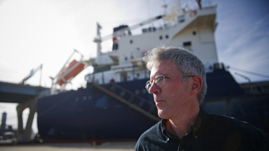Teachers' Domain - Digital Media for the Classroom and Professional Development
User: Preview

Source: Produced by the Wisconsin Educational Communications Board.
Come aboard with Pilot Randy Hayes on the Isa, a Great Lakes cargo ship carrying steel to the Port of Milwaukee, and explore the impacts of climate change on Great Lakes shipping. Learn how water level and shipping season affect the amount of cargo a ship can carry in this multimedia video produced by the Wisconsin Educational Communications Board.
Did you ever wonder where the steel in your washing machine came from, or how grains from the Midwest breadbasket reach the rest of the world? If you were to trace the life journey of these products, chances are they traveled the Great Lakes-St. Lawrence Seaway shipping system, a major world trade route connecting the Midwest and the Atlantic, supporting 30,000 jobs and $3 billion of business every year. How will this major thoroughfare be affected by climate change? It depends on the relative importance of two opposing impacts: lower water levels and shorter duration of ice cover on lakes.
Climate models predict that the Great Lakes region will experience higher temperatures and thus higher rates of evaporation. Though precipitation is expected to increase in winter and spring, the amount of summer precipitation is expected to decline (but we may see more frequent heavy precipitation events). According to most climate models, the net effect of all these factors will be to lower Great Lakes water levels by approximately 1 to 2 feet over the next century. Lake levels are also subject to natural fluctuation over the course of decades; UW-Madison lakes researcher John Magnuson predicts that the combination of these normal ups and downs and climate change impacts will result in "lower lows" every 15–25 years and less frequent "high" years.
Lower lake levels could mean major trouble for Great Lakes shipping and thus for businesses and consumers. A ship’s draft, or the distance between the waterline and the bottom of its main body, determines both the minimum depth of water it can safely sail and the maximum weight of cargo it can carry. Lower lake levels mean lower draft; for every one inch of lost draft, a 740-foot vessel loses 100 tons of capacity and a 1,000-foot vessel loses 270 tons. Researcher Harry Caldwell and colleagues say the costs of Great Lakes shipping could increase as much as 30 percent, due in part to this "light-loading" of cargo when waters are low, increasing the number of trips needed.
The other method of mitigating lower lake levels is also costly: dredging connecting channels and harbors. Currently, the federal government maintains 27-foot depths in these channels, but dredging projects greater than 27 feet require authorization of Congress. Hydrologist Frank Quinn predicts that these current levels will be inadequate in many channels within 30 years, requiring deeper dredging. However, dredging in the Great Lakes may be complicated by the presence of toxic contaminants in sediments from decades-old industrial waste.
Some of the detrimental effects of lower lake levels may be counterbalanced by longer shipping seasons. Based on climate models that forecast more ice-free days, Quinn predicts that the shipping season may be one to three months longer and costs may drop somewhat as ice-breaking expenses decrease. One thing is certain: Great Lakes shipping, an industry predicated on stable lake levels, will need to adapt to more uncertain conditions.
Here are suggested ways to engage students with this video and with activities related to this topic.
 Loading Standards
Loading Standards